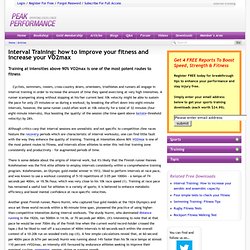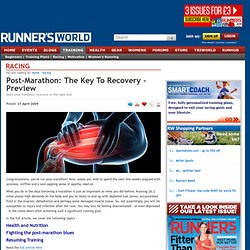

Interval Training: how to improve your fitness and increase your VO2max. Cyclists, swimmers, rowers, cross-country skiers, orienteers, triathletes and runners all engage in interval training in order to increase the amount of time they spend exercising at very high intensities.

A runner scampering along without stopping at his/her current best 10k velocity might be able to sustain the pace for only 25 minutes-or-so during a workout; by breaking the effort down into eight-minute intervals, however, the same runner could often work at 10k velocity for a total of 32 minutes (four eight-minute intervals), thus boosting the 'quality' of the session (the time spent above lactate -threshold velocity) by 28%. Although critics carp that interval sessions are unrealistic and not specific to competition (few races feature the recovery periods which are characteristic of interval workouts), one can find little fault with the way they enhance the quality of training. VO2max Zatopek's amazing 100 x 400m reps The hard-working Czech was known to rattle off 100(!)
Blood lactate. Increasing speed: short intervals. One of the key short-interval puzzlers is finding the combination of intensity, work-interval length and recovery -interval duration which will have the greatest impact on fitness.

Fortunately, scientists at the University of Vermont have recently quantified the benefits of different kinds of short-interval work-outs. In this study, a total of eight athletes tried out the following three work-rest combinations during separate short-interval sessions: (1) 40 seconds of work followed by 20 seconds of rest (40-20), (2) 30 seconds of work followed by 30 seconds of rest (30-30), and (3) 20 seconds of work followed by 40 seconds of rest (20-40). Each interval workout consisted of 15 total work-rest combinations and therefore lasted for a total of 15 minutes.
If you're interested in producing a lot of lactic acid during a short-interval session (to boost anaerobic power and increase lactic-acid tolerance) the most outstanding workout would again be the 40-20 at 110 per cent, which raised blood- How To Improve Your Speed Endurance. These speed endurance drills will help you to maintain a higher work rate for longer.

They are excellent for improving performance in sports such as football, soccer, hockey and basketball. Any athlete that is required to repeat high intensity sprints in quick succession can benefit from this type of training. RunMyGeek. Great Wall Marathon ® Post-Marathon: A Voyage of Recovery (Preview) I think it was Hal Higdon that has written online plans for various gaps between marathons, the minimum being 4 weeks.

(I have a couple pinned on my wall at work so don't have the exact link.) e.g. the 6 week gap has a max of only 16 miles lsr and that on the sunday of the 4th week after the mara weekend, and that is when you are trying to get a bit of training in for the next one, so I wouldn't do 20 so soon. You could adapt these plans or something else to make a maintenance plan. I believe it is better to keep a small number of mainly quality sessions per week rather than a few quantity sessions if you are going into maintenance mode. This is because VO2max is preserved better by the relatively high intensity sessions. Galloway has a book for all-year training but I haven't seen it. Personally, once recovered I wouldn't want my maintenance plan to have gaps longer than two days and I wouldn't use long runs as a primary form of maintenance. Alimentation. Running and Shin Splints. Shin splints are small tears in the area where the lower leg muscle attaches to the tibia, aka the shin bone.

The tears result from overuse, and since pavement taxes your muscles more than a treadmill, many runners complain of shin pain when they first begin outdoor runs. Shin splints often occur because the calf muscle becomes stronger than the tibialis anterior, the muscle on the outside of the shin. Even if the ache isn't that bad, it's still a minor injury. Pushing through the pain could result in more severe tears — an injury that could sideline your running routine altogether.
Check your form: Are you a heel striker? Réussir sa surcharge glucidique. Mensuel de foot et d'eau fraîche.